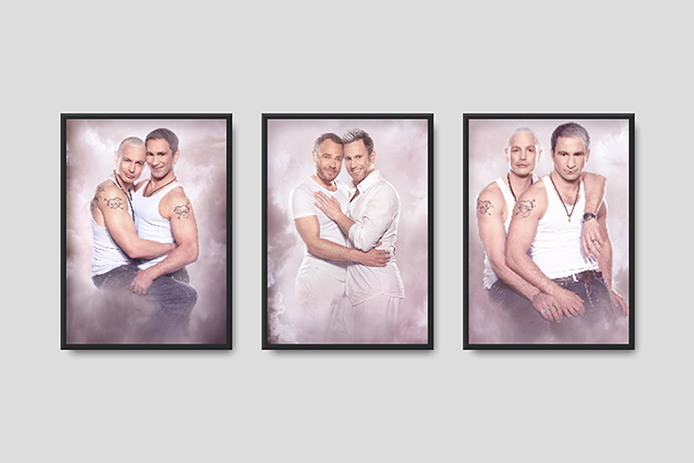
HBTQ+ REPRESENTATION I KONSTHISTORIEN
Utställning skapad för Örnsköldsviks Museum & Konsthall som tar dig med på en resa genom konst historien och de många representationerna av queerliv, kulturer och identiteter ställda tillsammans med samtida verk av internationella och lokala konstnärer som visar deras interproportioner av queer representation och teman.
Denna utställning fokuserar på queertolkningar, teman och representation i konsthistorien. När grupper är marginaliserade eller uteslutna ut den generella historiebeskrivningen handlar det om att läsa mellan raderna, dechiffrera koder och symbolik, för att hitta representation. Syftet med utställningen var att visa att queera identiteter alltid har funnits och varit representerade i konsten.
Konst är en skildring och ett uttryck för livet. Sexualitet är en integrerad del av livet. Historiskt sett har skildringen av erotisk kärlek alltid varit ett av konstens huvudämnen. Men hur är det med gestaltningen av queer kärlek i konsten? När fanns de första avbildningarna av det? Skildrades det öppet, eller visades bara tvetydiga antydningar om ämnet? Låt oss dyka in i konstens och queerkulturens historia!
Queer Konst
Queerkonst, HBTQ+-konst eller queer-estetik, refererar i stora drag till moderna och samtida bildkonstpraktiker som bygger på lesbiska, homosexuella, bisexuella, transpersoner och olika icke-heterosexuella, icke-ciskönade bilder. Samtida konstnärer som identifierar sina praktiker som queer, betecknar ofta sin konst som Queerkonst. Queer konst erbjuder ofta alternativ till det heteronormativ konst, antar ”förbjudna” eller i somliga länder kriminaliserade ställningstaganden och begär. Queerkonst praktiker växer fram mycket olika beroende på sammanhang, vars synlighet kan sträcka sig från att förespråkas för, till att omvänt mötas av motreaktioner, censur eller kriminalisering.
Queer art är ett begrepp som använts för att retroaktivt hänvisa till det historiska verk skapade av HBTQ+-konstnärer som praktiserade vid en tidpunkt innan dagens terminologi med ”lesbisk”, ”homo”, ”bisexuell” och ”trans” fanns. Utan att hålla sig till någon speciell stil eller medium, kan queerkonstpraxis sträcka sig över performancekonst, videokonst, installation, teckning, målning, skulptur, fotografi, film, glas och mixed media, bland många andra.
Att queera historiska verk
I motsats till bilder och föremål skapade från antiken och framåt bjöd jag in samtida konstnärer (internationella och lokala) att visa sina queera representationer för att både skapa kontrast men också visa en kontinuitet och ett sammanhang. Bilder på den transsexuella gayikonen Amanda Lepore kontrasterades med Jusepe de Riberas porträtt av den skäggiga damen Magdalena Ventura med sin man och son (1631), illustrationer av samkönade par från antiken till medeltiden till fotografier från 1800-talet – seklet kontrasterades med homoerotiska motiv av moderna fotografer som visar uttryck för homosexuell kärlek och närhet. Religiösa och mytologiska motiv som varit återkommande motiv genom hela konsthistorien fick en modern tolkning. Bruce Webers homoerotiska svartvita bilder av män i fick kontinuitet genom Lina Eidenberg Adamos färgfoton i samma tradition som också återspeglades i Richard McLarens fotoserie av Victoria Silvstedt och Anna Nicole Smith där de experimenterade med lesbisk kärlek och den bisexuella normen.
REPRESENTATION
Lärare måste åta sig att upphäva den systemiska tystnaden av queerfigurer genom historien. Historieundervisning är en mångfacetterad utforskning. Det är en utforskning av tidigare orsaker och effekter. Det är en utforskning av andra människors liv och kulturer och sammankopplingar. Det är en utforskning av triumfer och misslyckanden. Det är en utforskning av sig själv. Dessa måste vi kunna belysa genom representation. Vi måste kunna se oss själva i vår tid, men det är lika viktigt att kunna se oss själva representerade i historien. Om vi inte kan se oss själva speglade i historien, indikerar det hur oviktiga vi var.
”Jag kunde inte hitta mig själv i historien. Ingen som jag verkade någonsin ha funnits.”
Leslie Feinberg skriver i Transgender Warriors.
Konsthistorikern Alex Pilcher konstaterar i A Queer Little History of Art att biografisk information om queerkonstnärer över hela konsthistorien ofta utelämnas, förringas eller på annat sätt tolkas under antagandet om en heterosexuell identitet. Till exempel, ”[den] samkönade partnern blir den ”nära vännen.” Den konstnärliga kamraten framställs som det heterosexuella kärleksintresset”, med ”homokonstnärer diagnostiserade som 'celibata', 'asexuella' eller 'sexuellt förvirrade'.”
Konstnärer utvecklade visuella koder för att beteckna queerness i hemlighet. Under 1920-talet skapades Hollywood Production Code som censurerade och förbjöd skildringar av ”sexperversion” från filmer producerade och distribuerade i USA fram till 1968. Genom att använda queera koder och symbolik kunde viss representation av queera identiteter glida förbi den hårda censuren.
I ett försök att föreställa sig queerkonst som en helhet riskerar man att domesticera queerpraktiker och jämna ut den radikala karaktären och specificiteten hos individuella praktiker. Richard Meyer och Catherine Lord hävdar att med den nyvunna acceptansen av begreppet ”queer” riskerar den att bli mer av ett ”livsstilsvarumärke eller nischmarknad”, när det som en gång var rotat i radikal politik blir mainstream, vilket tar bort dess transformativa potential. En som tar sig tid att studera queerkultur och dess effekter på människor idag kan se att det Queer konst inte bara är ett ”livsstilsvarumärke eller nischmarknad.” Det är en del av en individs identitet och snarare än nisch handlar det om gemenskap av andra som delar samma ideal och öppen sexualitet.
Några av de medverkande konstnärerna och modellerna: Pierre et Gilles, Bingo Rimér, Anna Nicole Smith, Victoria Silvstedt, Amanda Lepore, Jeffree Star, Petter Askergren, Paolo Roberto, Birgitta Ohlsson, Sofia Wistam, David Hellenius, Peter Jihde, Tilde Fröling, Regina Lund, Ola Svensson, Christo Willesen mfl.
EXEMPEL UR UTSTÄLLNINGEN

"Blandningen av nya och gamla konstverk visade både sambandet mellan dem och fick mig även att se de äldre konstverken ur ett nytt perspektiv"
"En fantastisk utställning som visar att vi inte är ensamma. Vi har alltid funnits där, marginaliserade men närvarande."
"Utställningen var både intressant och lärorik. Många vackra bilder av både kända och ovanliga verk. Det var intressant att se hur nutiden upprepar historiska skildringar"


















